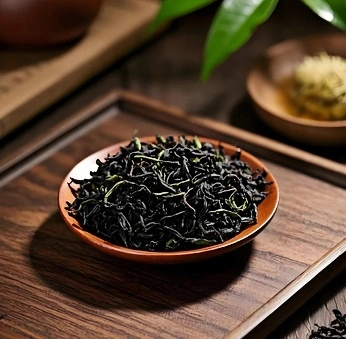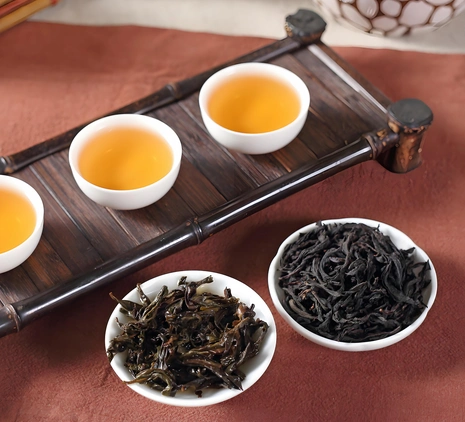Chinese oolong tea embodies centuries of artisanal mastery, whispering stories of mist-wrapped mountains and sun-drenched terraces in every cup. From the mineral “rock rhyme” of Wuyi rock oolong tea to the creamy orchid perfume of Anxi Tieguanyin tea, and the single-bush artistry of Phoenix Dan Cong oolong tea, this noble tea category offers a tapestry of flavors that dance on the palate. Imagine inhaling a bracing floral bouquet, then tasting warm toasty notes and a lingering, jade-green sweetness—this is the magic of Chinese oolong tea.
In this guide, we’ll journey through its origins, signature styles, healthful Chinese oolong tea benefits, and expert brewing techniques. Prepare to awaken your senses and embrace the rich ritual of China’s most celebrated teas.
What Is Chinese Oolong Tea?
Chinese oolong tea is a partially oxidized tea that bridges the worlds of green and black tea. Crafted through a delicate semi-oxidation process (10–70%), oolong leaves are withered under sun and shade, gently bruised to trigger enzyme activity, then carefully roasted or pan-fired to lock in aroma. Originating in Fujian and Guangdong provinces, oolong’s history spans the storied tea gardens of 17th-century traders and imperial connoisseurs. Each regional style—from the cliff-side “yancha” to the garden-row “tieguanyin”—expresses unique terroir and centuries-old technique.

Major Styles of Chinese Oolong Tea
Wuyi Rock Oolong Tea
Grown on rocky cliffs of the Wuyi Mountains, Wuyi rock oolong tea boasts a signature “rock rhyme” (yan yun): a mineral-rich backbone woven with roasted chestnut and subtle orchid sweetness. Ideal for connoisseurs, its charcoal roast delivers depth without overpowering the leaf’s natural bouquet.
Anxi Tieguanyin Tea
Hailing from Anxi County, Anxi Tieguanyin tea is famed for its creamy texture and floral top notes. Often lightly roasted, Tieguanyin exhibits lush flavors of gardenia and lily, with a soft, milky mouthfeel that soothes the senses.
Phoenix Dan Cong Oolong Tea
From Guangdong’s Fenghuang Mountain, Phoenix Dan Cong oolong tea—“single-bush oolong”—offers cultivars like Honey Orchid and Duck Shit Aroma. Each mother tree yields a unique “xiang,” or fragrance, ranging from honeyed florals to bold mineral spice.
Other Notable Styles
- Guangdong Dan Cong: Floral-fruity bursts reminiscent of lychee or mango.
- Taiwanese Oolongs: High-mountain teas with bright orchid scents and smooth bodies.
Flavor Profiles & Tasting Notes
Chinese oolong tea unfolds in layered symphonies:
- Floral: Jasmine, orchid, gardenia.
- Fruity: Peach, apricot, lychee.
- Roasted: Chestnut, cocoa nibs, caramel.
- Mineral: Slate, wet stone, sea spray.
Terroir—soil composition, altitude, humidity—and roast level shape these notes. A lightly roasted Tieguanyin sings with florals; a heavily roasted Wuyi oolong resonates with smoky depth.

Health Benefits of Chinese Oolong Tea
Chinese oolong tea benefits extend far beyond pleasure:
Antioxidant & Metabolism Boost
Rich in polyphenols and catechins, Chinese oolong tea supports free radical scavenging and may gently elevate metabolic rate, assisting healthy weight management.
Heart Health & Blood Pressure
Studies link oolong’s theaflavins and thearubigins to improved vascular function and moderate Chinese oolong tea and blood pressure support, especially when enjoyed regularly.
Digestive Support & Gut Health
The tannins and enzymes in oolong soothe digestion, reducing bloating and nurturing gut flora—paralleling the probiotic qualities often attributed to Pu Erh tea benefits.
How to Choose Quality Chinese Oolong Tea
- Leaf Appearance
- Look for whole, tightly rolled leaves with visible tips.
- Color varies by style: jade-green for Tieguanyin, dark olive for Wuyi.
- Aroma & Origin Labels
- Authentic teas carry provincial stamps (e.g., Fujian, Guangdong) and cultivar names.
- Fresh dry leaves should exude signature fragrances—orchid, orchid-wood, or mineral.
- Grade & Harvest Season
- Spring harvests yield the most aromatic leaves.
- Higher grades denote finer hand-picked buds.
- Trusted Vendors & Storage
- Purchase from reputable tea houses.
- Store in airtight, light-proof containers away from moisture and odors.
Brewing Chinese Oolong Tea
Ideal Water Temperatures & Steep Times
| Style | Water Temp | Steep Time |
|---|---|---|
| Anxi Tieguanyin | 90–95 °C | 2–3 min (West) |
| 5–10 s (Gongfu) | ||
| Wuyi Rock Oolong | 95–100 °C | 3–4 min (West) |
| 10–15 s (Gongfu) | ||
| Phoenix Dan Cong | 90–95 °C | 3–4 min (West) |
| 10–15 s (Gongfu) |
Gongfu-Style vs Western-Style Brewing
- Gongfu-Style: High leaf-to-water ratio in a gaiwan, multiple short infusions reveal evolving depth.
- Western-Style: One teaspoon per cup, single longer steep—ideal for daily convenience.
Multi-Infusion Tips
- Increase steep time by 5–10 s per infusion.
- Notice shifting aromas: florals fade to roasted notes, then mineral echoes.
- 🔗 For more tea brewing methods, check out the YouTube video explaining the brewing methods.

Oolong Tea Pairings & Recipes
- Savory: Steamed dim sum, grilled fish, light cheeses.
- Sweet: Almond cookies, fruit tarts, honey-glazed pastries.
- Cold Brew: 10 g leaf per liter cold water, 8–12 h, strain and serve over ice.
- Tea Blends: Mix 20% Pu Erh tea with 80% Chinese oolong for a layered infusion that marries mineral depth with smooth sweetness.
FAQs About Chinese Oolong Tea
- Which oolong tea is best for beginners?
Try Anxi Tieguanyin tea for its gentle florals. - How many infusions can I get?
Quality oolongs yield 6–10 gongfu steeps. - Is oolong tea caffeinated?
Yes—moderate caffeine levels provide alertness without jitters.
Conclusion: Explore the World of Chinese Oolong Tea
From the misty cliffs of Wuyi to the sunlit terraces of Anxi and the single-bush marvels of Phoenix Mountain, Chinese oolong tea invites you into a realm of sensory wonder. By selecting quality leaves, mastering brewing techniques, and savoring each infusion, you unlock the vibrant floral, fruity, roasted, and mineral notes that define China’s finest teas. Begin your tasting journey today—one sip at a time.



